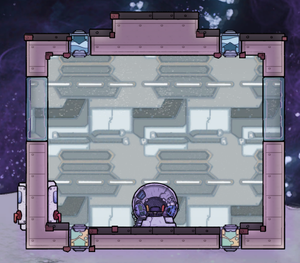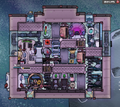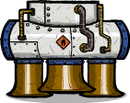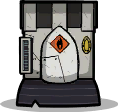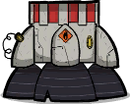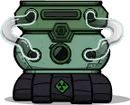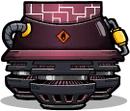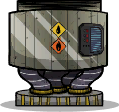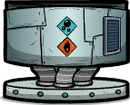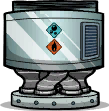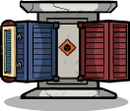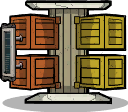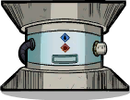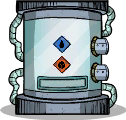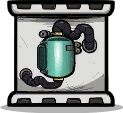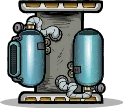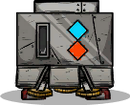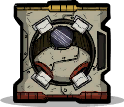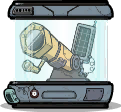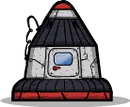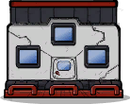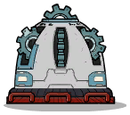Spacefarer Module
Multiple Duplicants can travel in and command the Spacefarer Module. It has an interior space of 10x8 tiles, which is significantly more space than the 28 tiles of the Solo Spacefarer Nosecone. It can also be anywhere in the middle of the rocket rather than being required to be the top module.
The Spacefarer Module is the second and final module unlocked in the research tree that can hold duplicants. It requires Applied Science Research at a Materials Study Terminal to unlock. Once unlocked, this module is generally advised for any rocket that can afford the height requirement due to its expanded interior, and it is required in order to launch a Drillcone rocket.
Interior
The interior starts out filled with Vacuum. The walls of the interior are special tiles that cannot be deconstructed: Rocket Wall (Steel), Rocket Window (Diamond), and Gas/Liquid Spacefarer Input/Output Port (Steel). All of these wall tiles begin at 20°C. There is a Rocket Hatch in the lower left which allows Duplicants to travel in and out of the module while the rocket is landed. A Rocket Control Station made of 100kg of Copper Ore starts in the center, but it can be deconstructed and built elsewhere.
The livable furnishings of the interior need to be designed by the player, and there are countless possible designs for various mission objectives and research tiers. At a minimum, the module needs to sustain Duplicant life for the duration of the trip, which is typically in the range of 2-10 cycles. This usually means Duplicants will need a bed, a toilet, an oxygen supply, and a food supply. The module also requires that the Rocket Control Station be built in order for the rocket to take off and change destinations. However, the Rocket Control Station is not strictly required while the rocket is in flight if you are willing to accept the flight speed penalty.
The interior is perfectly insulated from the rocket module's ambient environment in every way: temperature, gas/liquid leaks, radiation, etc. This makes the Spacefarer Module surprisingly effective as a controlled chamber for farming, ranching, industry, etc. aside from its primary use in rocketry. Spacefarer Modules can be built directly on a Rocket Platform with no engine, and this can be done anywhere in an asteroid, not just in the Space Biome.
Aside from Duplicant access, transporting materials and energy in an out of a Spacefarer Module can be done with the builtin liquid and gas ports which have connections on the rocket module's exterior, and with fittings for power, gas, liquid, and conveyor rails which connect to other rocket modules.
Built-in Ports
An update to the DLC introduced built-in ports in the hull of the module. These allow transfer of liquids and gases into the interior of the module itself, through the ports on the exterior of the module when the rocket is grounded. These are not connected to any other modules in any way.
When the rocket is in space, the output ports do absolutely nothing. The input ports, however, vent any fluids out into space.
- This is useful for removing accumulated Carbon Dioxide, and also heat through the removal of the gas.
Output Port Fittings and Cargo Modules
The following devices with dedicated ports have to be installed on the floor of the module, if the player wishes for ease of loading the module with supplies; furthermore, the rocket must have the prerequisite modules for these to work, because they can only draw supplies from these modules.
- Liquid Output Fitting: This requires a Liquid Cargo Tank or Large Liquid Cargo Tank to be included in the rocket to work. The player is likely to use this to load Liquid Reservoirs with Water and maybe spare Petroleum for refueling stops.
- In the case of Petroleum, this must go into the cargo tank(s); the fitting will not draw from fuel tanks.
- Similarly, this device won't draw Liquid Oxygen from any Liquid Oxidizer Tank.
- Gas Output Fitting: This requires a Gas Cargo Canister or Large Gas Cargo Canister to work.
- Conveyor Loader Fitting: This requires a Cargo Bay or Large Cargo Bay to work.
- This won't draw solid oxidizers from Solid Oxidizer Tanks either.
The smaller cargo modules suffice, if the player's intention is to just load the module with supplies. The modules can be deconstructed later.
Input Port Fittings and Refuelling
Ostensibly, oxidizers and fuel could be carried in Liquid Reservoirs in the interior. The solid ones could be readily taken out of the rocket for refueling at resupply stops. However, the liquid ones require Liquid Intake Fitting, and a Liquid Cargo Tank or Large Liquid Cargo Tank to be built onto the rocket.
Furthermore, a Liquid Rocket Port has to be built in order to draw fuel from the tank, and then piping has to be built from the output port of the Rocket Port to the input port of the fuel tank to refuel. (If the fuel is temperature-sensitive, insulated piping is needed, and this requires more materials.)
- Thus, bringing along some building materials will be necessary.
- The player also needs to build a cut-off system to avoid over-fueling; getting the excess fuel back into storage is a headache.
This seeming work-around for resupplying also involves a lot of micromanagement, as should be evident already.
Fittings must also be placed on the floor; ceiling fittings are not possible.
Possible Configurations
The Rocket Control terminal can be deconstructed and reconstructed elsewhere; the terminal does not count as industrial machinery. Fittings also do not count as industrial machinery.
For walking surfaces, Metal Tiles made from Gold is recommended, both to speed up movement and as bling for a Decor-provided Morale boost.
The floors should be strategically placed - bordered by Pneumatic Doors - to allow climbing and thus minimizing the use of ladders.
Any configuration will have to consider the removal of Carbon Dioxide and cooling of the interior sooner or later.
- In the case of cooling, it might be better to just rebuild the module instead, but of course this requires landing somewhere.
- It is possible to replace one of the tiles and containers with a farm plot to plant a Wheezewort, but the crew will be taking massive doses of rads.
This creates three viable rooms: the Washroom, Mess Hall and Barracks. The Orbital Lab can be swapped for a telescope; the Canister Emptier was there to expend some Oxygen bottles that were left behind from worn suits and masks.
Exploits
There are various exploits that take advantage of the special characteristics of rocket module interiors. To start, the rocket module takes up 5x4=20 tiles of space but the interior is 10x8=80 tiles of space. Building Spacefarer Modules in the middle of your base effectively expands your usable space. The insulated nature of a Spacefarer Module can be an advantage or a nuisance depending on what you do with it.
The walls of the Spacefarer Module cannot be deconstructed by Duplicants, but can be destroyed through other means, which gives construction access to the full 32x32=1024 space of tiles rather than just the intended 10x8=80 bounds. The original background acts as a backwall to prevent gas from being lost into the vacuum of space, but Drywall or some other method must be used outside the original background. One method of breaking out is to melt the tiles at 2426.9°C for Steel and 3926.9°C for Diamond. Note that the two tiles that contain the Rocket Hatch are always at 21°C and are unaffected by any type of heat change.
Another exploit allows building multiple Spacefarer Modules in a single rocket, but unlike the above exploits, this results in unstable and buggy behavior.
Finally, the normal 50% loss in mass when digging natural Solid tiles is bypassed when deconstructing a Spacefarer module with solid natural tiles in it. This will allow recovery of 100% of mass. This may be useful for a variety of purposes, such as:
- Solid-solid phase changes
- Shove Vole ranching
-
 Corium recovery from Research Reactor meltdowns
Corium recovery from Research Reactor meltdowns - Easy recovery of natural
 Solid Nuclear Waste tiles or other natural tiles used for Pip-made wild Mutated Plant farms
Solid Nuclear Waste tiles or other natural tiles used for Pip-made wild Mutated Plant farms
See Also


